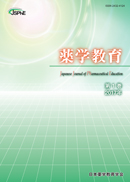Current issue
Displaying 1-10 of 10 articles from this issue
- |<
- <
- 1
- >
- >|
Review Article
-
Article type: Review Article
2024 Volume 8 Article ID: 2023-044
Published: 2024
Released on J-STAGE: March 09, 2024
Download PDF (376K) Full view HTML
Special Topics | Recommendations from social needs by specialists in various fields
-
Article type: Review Article
2024 Volume 8 Article ID: 2024-002
Published: 2024
Released on J-STAGE: March 09, 2024
Download PDF (476K) Full view HTML -
Article type: Review Article
2024 Volume 8 Article ID: 2024-003
Published: 2024
Released on J-STAGE: March 09, 2024
Download PDF (1843K) Full view HTML -
Article type: Review Article
2024 Volume 8 Article ID: 2024-004
Published: 2024
Released on J-STAGE: March 09, 2024
Download PDF (330K) Full view HTML
Original Article
-
Article type: Original Article
2024 Volume 8 Article ID: 2023-042
Published: 2024
Released on J-STAGE: March 01, 2024
Download PDF (1297K) Full view HTML -
Article type: Original Article
2024 Volume 8 Article ID: 2023-036
Published: 2024
Released on J-STAGE: March 01, 2024
Download PDF (1561K) Full view HTML
Short communication
-
Article type: Short communication
2024 Volume 8 Article ID: 2023-035
Published: 2024
Released on J-STAGE: February 28, 2024
Download PDF (430K) Full view HTML
Practical Article
-
Article type: Practical Article
2024 Volume 8 Article ID: 2023-034
Published: 2024
Released on J-STAGE: February 10, 2024
Download PDF (601K) Full view HTML -
Article type: Practical Article
2024 Volume 8 Article ID: 2023-041
Published: 2024
Released on J-STAGE: March 22, 2024
Download PDF (2905K) Full view HTML -
Article type: Practical Article
2024 Volume 8 Article ID: 2023-037
Published: 2024
Released on J-STAGE: March 28, 2024
Download PDF (1354K) Full view HTML
- |<
- <
- 1
- >
- >|
